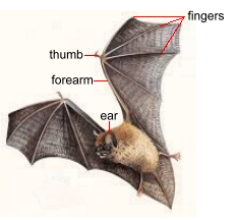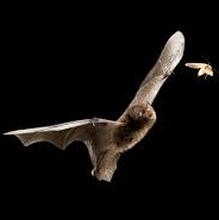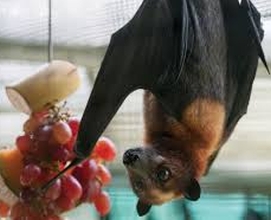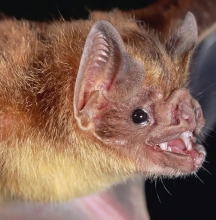  Bats are the only flying mammals, and belong to the order Chiroptera.
There are about 1000 species of bats worldwide. Bats range in size from a tiny hog-nosed bat called the Bumblebee bat that weighs less than a penny, making it the world's smallest mammal — to the so-called flying foxes, which can have wingspans of up to almost 2 metres.
Bats are the only flying mammals, and belong to the order Chiroptera.
There are about 1000 species of bats worldwide. Bats range in size from a tiny hog-nosed bat called the Bumblebee bat that weighs less than a penny, making it the world's smallest mammal — to the so-called flying foxes, which can have wingspans of up to almost 2 metres.
With an average life span of 20 years, bats have few natural predators. Owls, hawks and snakes will eat them, but bats are much more likely to succumb to diseases such as white-nose syndrome. The disease, named for a white fungus that grows on the muzzle and wings of bats, affects hibernating bats and has been detected in 37 states and seven Canadian provinces. It has decimated certain species more than others, having killed over 90% of northern long-eared, little brown and tri-colored bat populations in fewer than 10 years. Scientists are working to understand the disease.  Bats share characteristics of all mammals - hair, regulated body temperature, bearing their young alive, and nursing them. Infants grow rapidly and are able to fly in about three weeks. Bats are the only mammal that can truly fly. The structure of their wing membranes, the arrangement of the bones supporting them, and the positioning of the muscles provide bats with the lightness and maneuverability necessary for catching insects, hovering above flowers, or avoiding obstacles. The bones of the arm and the fingers are light, slender, and lengthened to support, spread, and manipulate the membrane. The thumb, usually with a sharp claw, is not attached but remains free for clinging to various surfaces.
Bats share characteristics of all mammals - hair, regulated body temperature, bearing their young alive, and nursing them. Infants grow rapidly and are able to fly in about three weeks. Bats are the only mammal that can truly fly. The structure of their wing membranes, the arrangement of the bones supporting them, and the positioning of the muscles provide bats with the lightness and maneuverability necessary for catching insects, hovering above flowers, or avoiding obstacles. The bones of the arm and the fingers are light, slender, and lengthened to support, spread, and manipulate the membrane. The thumb, usually with a sharp claw, is not attached but remains free for clinging to various surfaces.
 Bats are small, secretive, feed at night, and are unfamiliar to most people. Some prefer to roost in barns, attics, caves or abandoned mines, hollow trees or rock crevices ... all places that provide safety from predators in the daytime, protection from the weather, and seclusion for rearing their young.
Bats are small, secretive, feed at night, and are unfamiliar to most people. Some prefer to roost in barns, attics, caves or abandoned mines, hollow trees or rock crevices ... all places that provide safety from predators in the daytime, protection from the weather, and seclusion for rearing their young. To survive in colder regions, bats either hibernate in places with high humidity and temperatures above freezing, or migrate to warmer areas where food is available. Unlike other mammals, the back limbs on bats are positioned so that the knees, when bent, point backward while the bottom of the feet face forward. The toes have claws which help in gripping and in hanging head downwards, the normal bat resting position.  The vast majority of bat species consume insects such as moths, beetles, gnats, and crickets. Large numbers of insects fly at night, and with the exception of spiders, there are few competitors for such food. Some small bats can catch up to 1,000 or more insects in a single hour. A nursing mother bat can catch more than 4,000 insects in a night.
The vast majority of bat species consume insects such as moths, beetles, gnats, and crickets. Large numbers of insects fly at night, and with the exception of spiders, there are few competitors for such food. Some small bats can catch up to 1,000 or more insects in a single hour. A nursing mother bat can catch more than 4,000 insects in a night. All bats can see, even though vision may be less important than other senses. To locate and catch prey, bats that eat insects use an acoustic orientation called echolocation. They emit a series of supersonic cries through the mouth and detect insects by the echoes reflected back. In addition to the ultrasonic sounds used in echolocation, bats also emit other sounds, possibly to communicate or to indicate emotion. The bat's ear is extremely mobile and sensitive to sound.  Some bats specialize in catching insects on land, like grasshoppers or roaches found on the ground or in trees. Other bats use their feet to snatch insects from the surface of ponds and lakes.
Those species that eat pollen, nectar, and in some instances, petals from flowers, are found mainly in the tropics and semitropics. Pollen, like insects, is highly nutritious. Fower-eating bats are usually small and have long pointed heads, long tongues, and the ability to hover and fly slowly.
Most of these bats rely on vision and their sense of smell to locate food rather than sonar. Unlike birds, bats are colour blind and so rely more on scent in choosing their food.
Some bats specialize in catching insects on land, like grasshoppers or roaches found on the ground or in trees. Other bats use their feet to snatch insects from the surface of ponds and lakes.
Those species that eat pollen, nectar, and in some instances, petals from flowers, are found mainly in the tropics and semitropics. Pollen, like insects, is highly nutritious. Fower-eating bats are usually small and have long pointed heads, long tongues, and the ability to hover and fly slowly.
Most of these bats rely on vision and their sense of smell to locate food rather than sonar. Unlike birds, bats are colour blind and so rely more on scent in choosing their food. A few species of bats are carnivorous, eating small frogs, lizards, and birds. Other species are known for catching fish and usually have huge hind feet and claws. The best known of the fish-eating bats is the fishing 'bulldog bat', Noctilio leporinus, of Central and South America. It uses sonar to detect ripples on the water made by the fish, and catches its prey with large hooked claws; spearing the fish with its canine teeth, it gathers it up in its wing membranes, bites through the skull and eats it, all in a matter of seconds.  The vampire bat of Central and South America feeds on blood,
mainly the blood of cattle, horses, and wild mammals such as deer and peccaries. It seldom bites humans.
The vampire bat of Central and South America feeds on blood,
mainly the blood of cattle, horses, and wild mammals such as deer and peccaries. It seldom bites humans. The harm from such bites arises not from the amount of blood lost, which is relatively small, but rather from the exposure of the livestock to secondary infections, parasites, and the transmission of viral-borne diseases such as rabies. Rabies occurs naturally in many wild animals. Actually, a higher incidence of the disease is found in skunks and foxes than in bats. But bats can harbour the rabies virus and should be handled with caution.  Bats are beneficial members of the animal community. They help to control night-flying insects, and in some instances pollinate flowers, and scatter the seeds of plants to allow their spread.
Bats are beneficial members of the animal community. They help to control night-flying insects, and in some instances pollinate flowers, and scatter the seeds of plants to allow their spread. Bat excrement (guano) is rich in nitrogen and in many places has been sold as fertilizer. In time, as we learn more of the bat's biology and habits, perhaps we can also adopt new attitudes that allow us to accept this soft furry creature as a natural and useful part of our environment. |